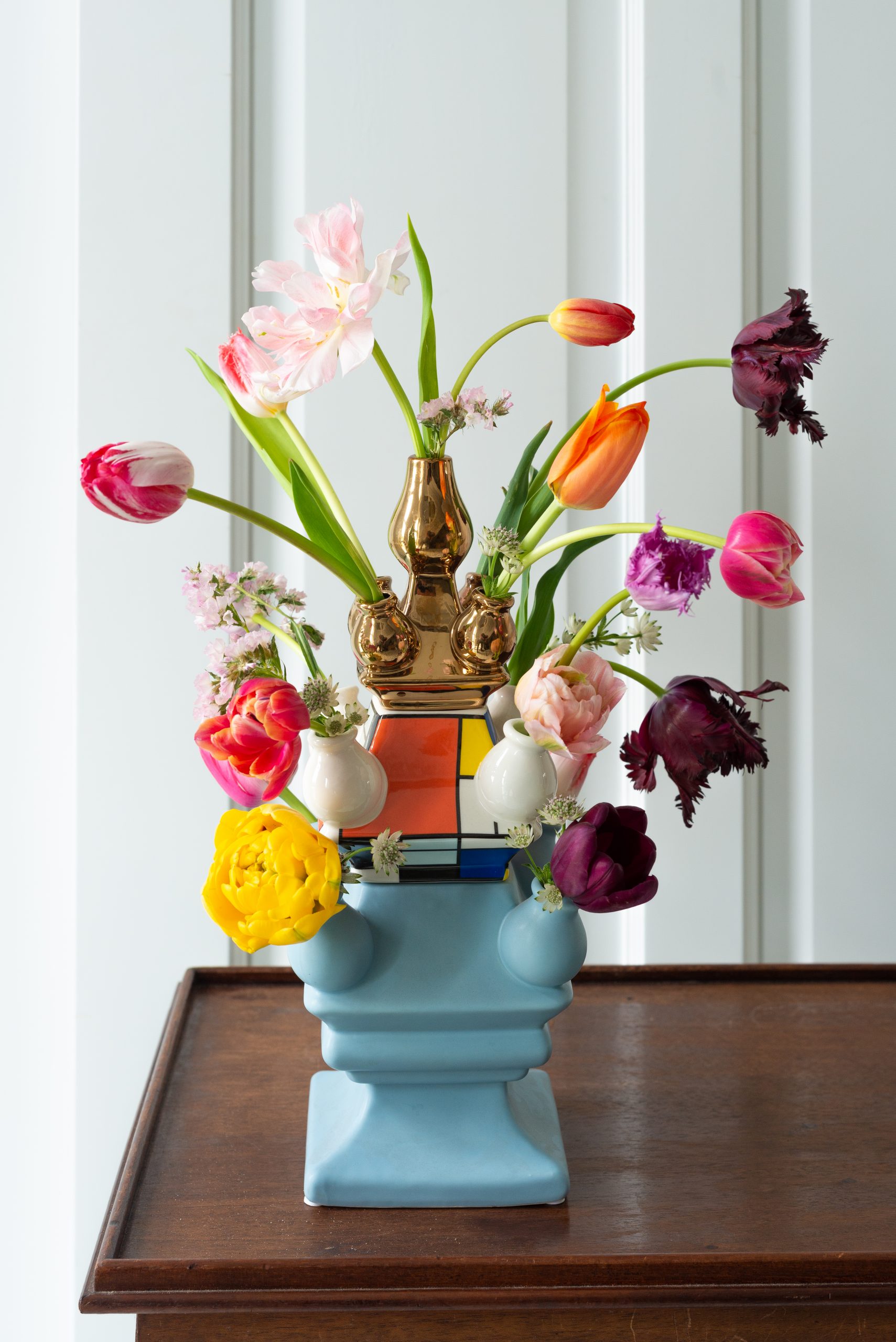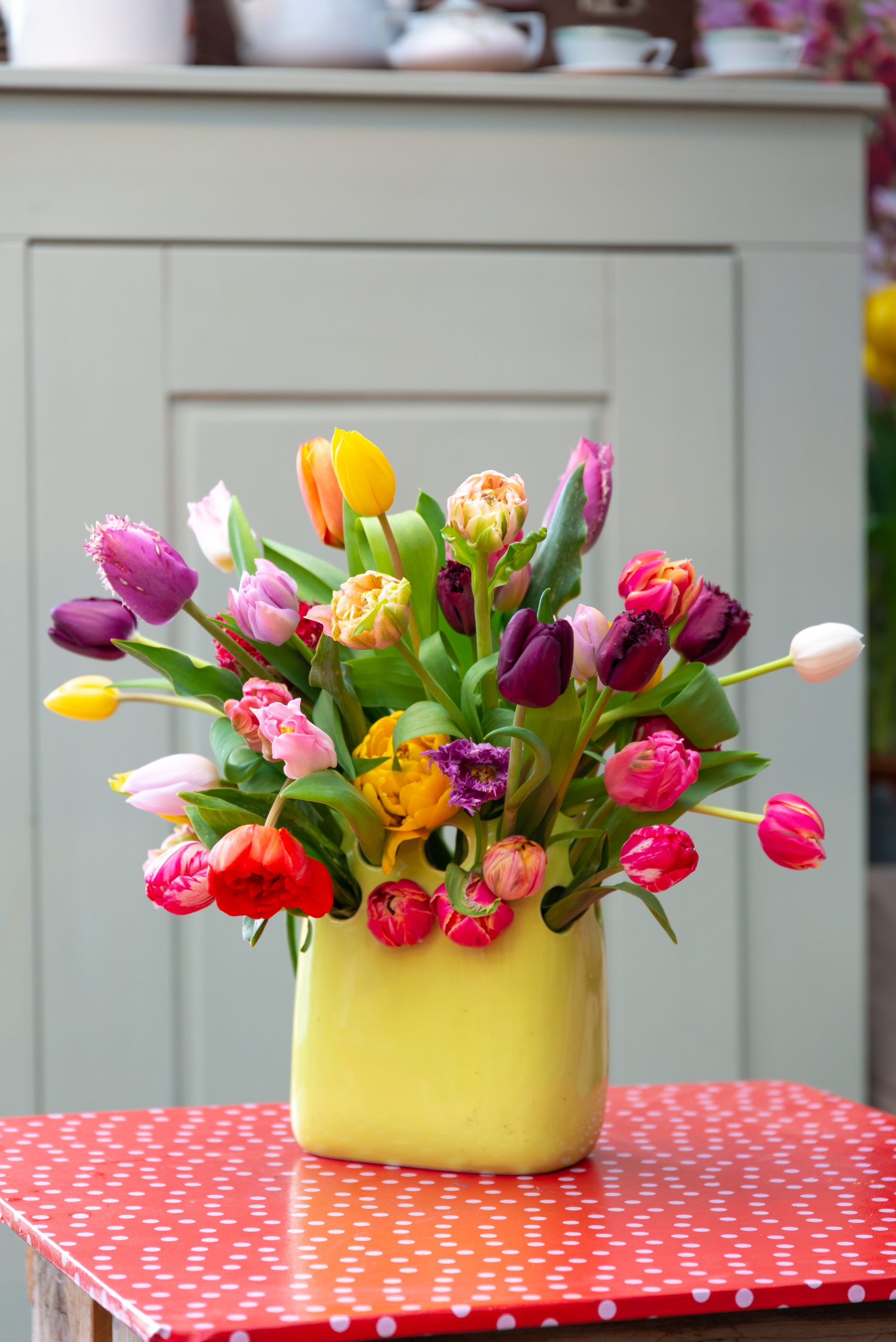- Olet täällä:
- tulips

Tulips
The tulip is a classic Dutch flower. Every year many tourists visit the Netherlands - the land of tulips - to admire the stunning tulip fields. But did you know that tulips did not originate from the Netherlands? We like to tell you more about the remarkable history of the tulip, and show you a number of varieties.
The history
The name ‘tulip’ derives from the word ‘Tulipa’. Tulipa is a Latin word which means: the flower that resembles a turban. During the 16th century this flower was cultivated and traded in Turkey and the surrounding region. Men there wore turbans. And that is how the name Tulipa arose. In the 16th century there were not many bulbs available, and only rich people were able to afford one or more tulips. Midway through the 16th century the first cargo of tulip bulbs arrived in Antwerp, marking the start of Dutch bulb cultivation. At that time a single tulip bulb was worth as much as an entire canalside merchant’s house in Amsterdam. In the 17th century the trade took off in the Netherlands and ‘tulip fever’ broke out. Tulips became very popular amongst the wealthy and were being sold on paper while the bulb was still in the ground. More bulbs were sold than were ultimately available. And that led to problems. Tulip fever - also called the tulip market bubble - collapsed midway through the 17th century, after which the bulbs were sold for a more acceptable price.
Important flower in the Netherlands
The tulip is still an important flower in the Netherlands. Nowadays our small country exports almost 2.5 billion tulip bulbs to other countries every year, and we are known as the country of clogs, windmills and tulips. The northern region of the province of Noord Holland boasts the world’s largest bulb fields, and attracts many tourists every year as a result.
Tulip types
Our webshop offers you an extensive range. In the webshop you can filter by tulip types, such as:
✴ Single tulip. This is the "standard" tulip and is available in all colors of the rainbow, except blue.
✴ Double tulip. The name says it all. This flower has double petals and therefore has a lot of volume.
✴ Parrot tulp. This flower has beautiful frayed petals. The parrot tulip is available in different colors.
✴ Fringed tulip. The petals of this flower are fringed and often have a crystal-like shine.
Which is your favourite colour?
Tulips come in many different colours and shapes. Each colour has a different meaning. Here is a list for you:
✴ The red variety symbolises loyalty, friendship and true love. You give this to someone you love.
✴ The pink variety represents luck and elegance. Wish someone good luck with a bunch of pink tulips.
✴ The purple variety represents royal dignity, but also peace. Purple tulips are therefore suitable for various occasions.
✴ The orange variety stands for the Netherlands. The colour also symbolises enthusiasm. For example, if you’re excited to see someone again after a long time, the orange tulip makes a great gift.
✴ The yellow variety represents warmth, pleasure and joy. Give this tulip to someone you want to cheer up.
✴ The white variety symbolises forgiveness, and could be given to someone and as a gesture to say ‘sorry’.
Care tips for professionals
Tulips tend to grow crooked. You can prevent this by wrapping them tightly in paper so that they become nice and firm. Tulips will grow another 5 to 15 cm in a bucket of water. Prevent them from growing too quickly by storing them for as short a time as possible, and in cool conditions. Avoid botrytis by working in a clean and dry way when you use the flower. If you are incorporating tulips in a bouquet or arrangement, bear in mind that the stem will continue to grow, so place them slightly lower in the bouquet. If you mix tulips with narcissi or daffodils in a bouquet, add bulb flower food to the water. Narcissi and daffodils exude slime when they have been cut. The food prevents this from having a harmful effect on the tulips.
Care tips for professionals
Tulips tend to grow crooked. You can prevent this by wrapping them tightly in paper so that they become nice and firm. Tulips will grow another 5 to 15 cm in a bucket of water. Prevent them from growing too quickly by storing them for as short a time as possible, and in cool conditions. Avoid botrytis by working in a clean and dry way when you use the flower. If you are incorporating tulips in a bouquet or arrangement, bear in mind that the stem will continue to grow, so place them slightly lower in the bouquet. If you mix tulips with narcissi or daffodils in a bouquet, add bulb flower food to the water. Narcissi and daffodils exude slime when they have been cut. The food prevents this from having a harmful effect on the tulips.
.jpg?v=240124112308)

Unique tulip picking garden
Tulip Day is a unique Dutch tulip festival, traditionally organised on the 3rd Saturday of January. This day marks the start of the tulip season. Every year, a real tulip picking garden is set up in the centre of Amsterdam and over 17,000 fans visit this unique garden. All visitors get to pick a bunch of tulips for free.
DJ Hardwell christened his own tulip on Saturday 20 January 2024 during National Tulip Day. The christening took place just before the official opening of the new tulip season at the Museumplein in Amsterdam. Hardwell is is one of the world's most popular DJs and his shows, like the tulip, are full of energy.
Tulips even have the ability to 'dance' a bit in the vase. In fact, they grow a bit and each flower spins in the direction it wants. The new 'Hardwell' tulip, with its special flower shape and colouring, was presented to the public for the first time on Tulip Day.
Inspiration
You can make an impression with tulips with a bouquet made solely from different colours of tulip. But tulips also do well when combined with other cut flowers.



 Nederlands
Nederlands  English
English  Français
Français  Deutsch
Deutsch  Español
Español  Româna
Româna  Polski
Polski  Slovensky
Slovensky  Slovenija
Slovenija  Italiano
Italiano  Svenska
Svenska  Magyar
Magyar  Latviešu
Latviešu  Suomi
Suomi  ελληνικά
ελληνικά  Ceština
Ceština  Hrvatski
Hrvatski